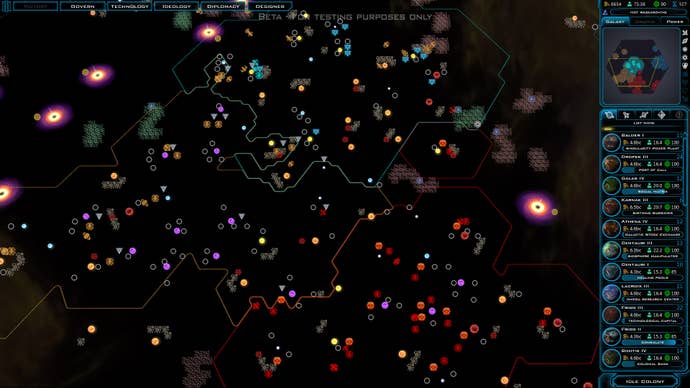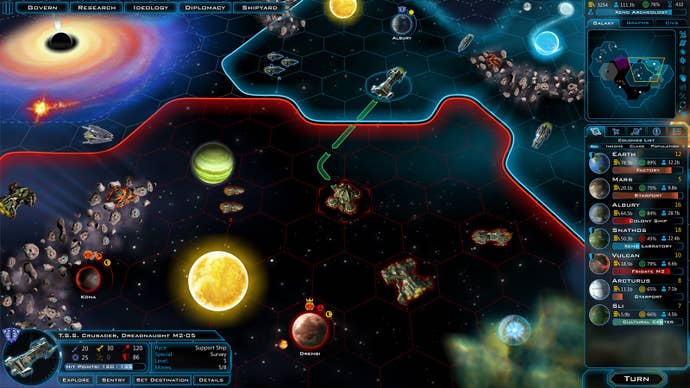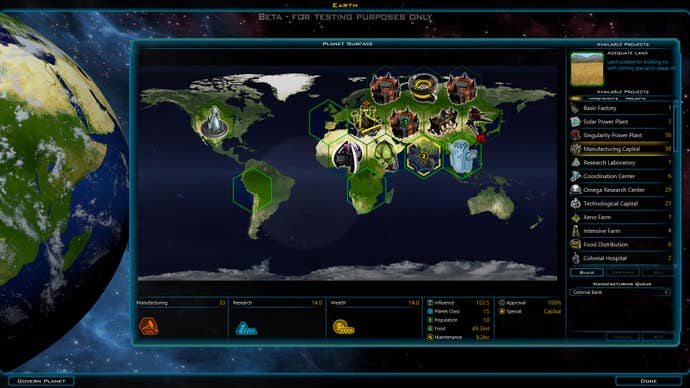Galactic Civilizations III: The Return of Diplomacy and the Religious Alien Mafia
As Beta 2 for Galactic Civilizations III launches, we talk to lead designer Paul Boyer about the game's new additions.
This article first appeared on USgamer, a partner publication of VG247. Some content, such as this article, has been migrated to VG247 for posterity after USgamer's closure - but it has not been edited or further vetted by the VG247 team.
If you've been playing the Alpha and Beta phases Galactic Civilizations III up until now, you've been playing a very combat-heavy game. A Conquest victory, winning by absolutely destroying your foes, was the only available victory condition in the game. That's the bane of Early Access, playing a stripped-down game to help the developers test out the core gameplay pillars.
No longer my friends. Today, Galactic Civilizations III moves into Beta 2, which adds Diplomacy, Trade, and another race to the mix, the Krynn. The tech trees for Diplomacy and Trade were already available in previous phases, but the systems have now been turned on, allowing players to experience a major part of previous Galactic Civilizations. Together, Diplomacy and Trade let you talk with other races to create treaties or trade credits, technology, ships, and resources. The new Beta phase also adds the new United Planets system, a galaxy-wide organization where all the races come together to collectively govern.

I spoke with lead designer Paul Boyer about the new additions to Galactic Civilizations III and how they push the game in different directions.
One of the big things with Trade and Diplomacy is they allow players to have new options when dealing with enemies. Instead of focusing on building a giant army, you can trade a stronger race for their army, negotiate a peace treaty, or impose an embargo that prevents them from building more ships and bigger cities. Boyer says these new options allow a more "sneaky and underhanded" style of play.
In Galactic Civilizations II, I used to speed down the Trade and Diplomacy trees first: the early bonuses would allow me to make horribly lop-sided trades with other races, like trading multiple useful techs for a simple one like Communications, or trading an entire war fleet for a few credits. Boyer says you can still out-fox the AI in Gal Civ III Beta 2, but that's part of working out all the kinks.
"It is still possible. It's one of the thing that we're balancing and will be balancing forever: essentially getting the AI to value things wisely," he explains. "The AI will not only check on how much it spent to get something or how much it costs to make, but also what its biggest priority is. If I'm the Drengin, military is my biggest priority. They focus on military and production first and we can multiply that by the base value of that tech, allowing the AI to say 'That is super-valuable to me. There's no way I'm giving that to you.'"

"We also don't like to say that you can never outsmart the AI. The AI in Gal Civ III Beta 2 is not the brightest and you will probably be able to trick it. This is the 'go out and break it' stage of development."
Galactic Civilizations fans will be very happy about the return of other victory conditions. Up until now, Conquest was the only victory condition available, favoring more militaristic players and races. These additional victory conditions include Influence, Research, Diplomatic, and Ascension.
The Influence victory has you spreading your influence across 75 percent of the map and holding that for ten turns. With the Research Victory, you research three Age of Victory techs and then use them to build an Ascension Gate and win. A Diplomatic victory involves getting everyone who's still alive to ally with you. Finally, an Ascension Victory has you holding onto a certain number of existing Ascension Gates in the galaxy to win.
"In Beta 2, we have enabled all but one of the victory conditions," says Boyer. "There's the also the United Planets victory - which isn't in yet - where you get everyone to elect you Supreme Leader of the Galaxy and you win that way."
That's not to say everything is available in Beta 2. Boyer admits that governments are still missing and the more advanced aspects of Trade and Treaties are currently locked. That said, the galaxy-spanning United Planets communal government is returning in Beta 2 and Boyer says there have been some big changes in the system.

"The United Planets is hugely different," he tells me. "On the surface, it probably won't appear that different, but the United Planets is a whole new dynamic to the game. Every fifth turn they elect a Chair-Being, who is responsible for the proposals that get voted on. You can use those resolutions to your advantage or the detriment of your enemies if you're in that position. This is where having strong allies will become really important. We also plan on letting the minor races into the United Planets and you can farm them for votes. You can suck up to people right before votes."
Like Trade and Diplomacy, the United Planets adds more options for dealing with friends and foes. In a costly war that you can't stop? Propose a Galactic Peace initiative at the next United Planets meeting and force peace down your opponent's throat. Getting screwed by other races' Tech Trading? Impose a ban on Tech trades for a certain number of turns. The United Planets is another meta-game on top of Galactic Civilizations III's 4X strategy game.
"They're still the Krynn Consulate, but the syndicate is running things from the shadows. They're a little bit mafia and a little bit church."
The Krynn Consulate re-enters the picture with Beta 2, but they're now under a new moniker: the Krynn Syndicate.
"The Krynn are a fun race. They're essentially a religious coalition of races, but they also have this darker side," says Boyer. "We're emphasizing that in Gal Civ III; we've even changed their name to the Krynn Syndicate. They're still the Krynn Consulate, but the syndicate is running things from the shadows. They're a little bit mafia and a little bit church. We're still fleshing out their dialog and getting their personality worked out."
"Their main power is in influence and approval; they're the perfect race for culture-flipping. You build temples that not only keep the planet happy, but also expand influence. They're also excellent at trade, with a smuggling trade route that gives them more money and another that allows them to war-profiteer. They even have one trade route that's not in Beta 2 that allows them to trade with races they're currently at war with. They have a really neat tech tree; I'm actually worried that they're a little overpowered right now."

Galactic Civilizations III builds upon the foundation established in the Galactic Civilizations II expansion, Twilight of the Arnor, which gave each race their own unique tech trees. That idea has been greatly expanded with the latest game.
"We've gone out of our way to make sure the trees really feel special, even if its only cosmetic in places, like making sure the dialog is reflective of the race you're playing," says Boyer. "[The Krynn] are different in that their Twilight tree wasn't really fleshed out, with this one little branch of unique things. I turned that into this whole Diplomacy branch called The Path, with all these influence improvements. Then they have the Jihad branch, which is their military tree. We're trying to flesh them out a bit more. It's not all in yet; their super abilities won't be in until Beta 3 for example."
Another new addition to Galactic Civilizations III in the earlier Alpha phase was the Shipyard. This structure is tied to specific planets and handles all of the ship-building in your empire. The Shipyard also allows players to design and build custom ships. Unfortunately, the system had some issues, notably that the shipyards were made of paper mache and easily destroyed.
"I'm pretty happy [with shipyards], but we still have a problem where it's too easy to kill them," Boyer admits. "So I gave them some defenses in Beta 2. I think the problem is that the AI isn't defending them right now. You end up with this 'you build a shipyard, I blow it up' loop. That's more of an AI problem and we do want to address that. We're definitely keeping them and we definitely like the general dynamic of them. I won't say that they're finished."

Boyer mentioned that there were some additions to the system that were on the table, like allowing multiple stars or planets to feed into a single Shipyard. In addition, there's the new changes to Colony Ships in Beta 2: instead of pulling from a single planet's population when a Colony Ship is created, you can now draw from multiple planets. Boyer also believes that Shipyard trading will make it into the game eventually, but he makes no promises.
"We've never claimed that our multiplayer was terribly balanced. Our aim is to make sure that everybody's equally broken."
Boyer and I ended our talk on multiplayer and the challenges of creating balanced competitive multiplayer in the wide sandbox that is Galactic Civilizations III. The mode is new feature for the Gal Civ series, so it's a bit of a learning experience for the team at Stardock.
"Our goal is to make sure that the multiplayer game feels as much like the sandbox game as possible," says Boyer. "We don't really want it to become a tournament game-- obviously we won't complain if it does. That's not our primary goal. Our primary goal is to make it feel like the single-player game, make it fun, and make it as balanced as possible. But as you add in things like custom races, people can create some wacky combinations that other combos won't be able to handle. That's the joy and pain of multiplayer."
"We've never claimed that our multiplayer was terribly balanced," he adds. "Our aim is to make sure that everybody's equally broken. We want everybody to have little exploits; you're the King of the World until everybody finds a different one. That's the key to a good multiplayer game."







